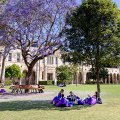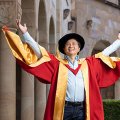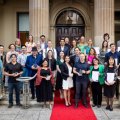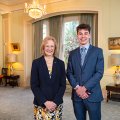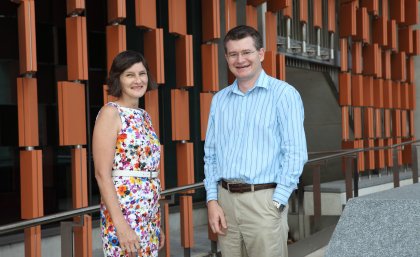
Virtual learning tools used to enhance teaching outcomes at The University of Queensland will be at the heart of new research this year.
The research has been enabled by two Office of Learning and Teaching grants totalling $397,000 awarded to Dr Chris Landorf from the UQ School of Architecture and Dr Pierre Benckendorff from the UQ Faculty of Business, Economics and Law.
UQ Deputy Vice-Chancellor (Academic) Professor Joanne Wright said UQ’s success in the second round of the Office of Learning and Teaching’s 2013 grants demonstrated the continued commitment of UQ staff to innovation in learning and teaching.
“These research projects explore how we engage students in active online learning through the use of practical simulations, rather than simply putting content or lectures online,” Professor Wright said.
She said online simulations had the potential to enrich Massive Open Online Courses (MOOCS), of which UQ is releasing four this year.
She said the ultimate winners were the students, as they were able to enrich their learning experiences.
“Online learners can choose the time and location of their classroom time, access is broadened, and the ability to share learning is enhanced,” Professor Wright said.
Dr Landorf will receive $220,000 to lead research into the creation and use of virtual learning environments, particularly for architecture students and other construction-related disciplines.
Digital images captured during the construction of UQ’s Advanced Engineering Building are a focus for the study.
“Construction needs to be understood as a complex interactive process, not just as an end product, Dr Landorf said.
“Because students have difficulty getting access to building sites, a resource such as this allows us to take the final product and peel back the layers to expose the building process over time.”
Traditionally, two-dimensional drawings have been used to communicate construction information.
“While developments in three-dimensional computer modelling are helping, increasingly complex buildings continue to stretch the capacity of construction teams to think through three-dimensional problems,” Dr Landorf said.
“We aim to provide a suite of interactive interdisciplinary learning activities that address this issue.”
Dr Landorf said the outcomes had the potential to benefit cross-disciplinary learning, in fields including civil engineering, construction management and quantity surveying.
The study is in partnership with The University of Newcastle and the University of South Australia.
Dr Benckendorff received $177,650 to lead research to identify how educators can effectively use online simulations to enhance graduate capabilities, particularly in business and related fields.
“It is vital that all university programs ensure students have strong decision-making and problem-solving skills applicable to real life situations,” Dr Benckendorff said.
“Online simulations have been widely used in business programs, but there has been little guidance or evidence of how these tools integrate with curriculum or evaluation of their effectiveness.
“The project will explore the important role of effective and innovative teaching practices that support the use of online simulations in business education.
“The evolving use of information and communication technologies in teaching and learning raises a whole series of questions ranging from the appropriateness of the ‘chalk and talk’ paradigm, through the role of assessment, to the need to cater for different learning styles,” he said.
The study is in partnership with: Griffith University, La Trobe University, University of South Australia and Victoria University.
UQ is also a partner institution in four further successful applications:
Title: Development and implementation of MathBench for Australian universities to improve quantitative skills of science and mathematics students
Lead institution: Deakin University
Partner Institutions: Griffith University, James Cook University, Monash University, The University of Queensland, The University of Sydney, University of Western Sydney, University of Maryland (USA)
Funding: $298,000
Title: The STEM Ecosystem: building cross-disciplinary leadership capacity in science, technology, engineering and mathematics (STEM)
Lead institution: RMIT University
Partner Institutions: The University of Queensland, The University of Sydney, University of Southern Queensland
Funding: $217,000
Title: Better judgement: improving assessors' management of factors affecting their judgement
Lead institution: Flinders University
Partner Institutions: The University of Adelaide, The University of Queensland;
Funding: $150,000
Title: Nationally shared curriculum resources for veterinary undergraduate learning in animal welfare and ethics
Lead institution: The University of Sydney
Partner Institutions: Charles Sturt University, James Cook University, Murdoch University, The University of Adelaide, The University of Melbourne, The University of Queensland, Massey University (NZ)
Funding: $378,000.
Media: Dr Chris Landorf, c.landorf@uq.edu.au; Dr Pierre Benckendorff, p.benckendorff@uq.edu.au

